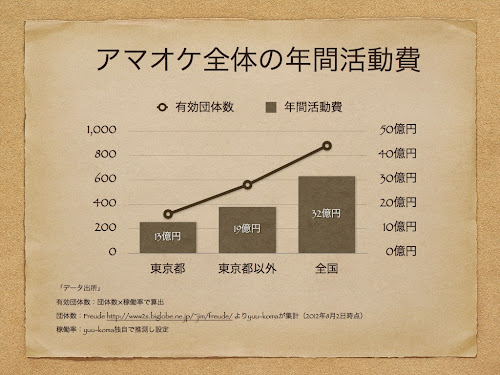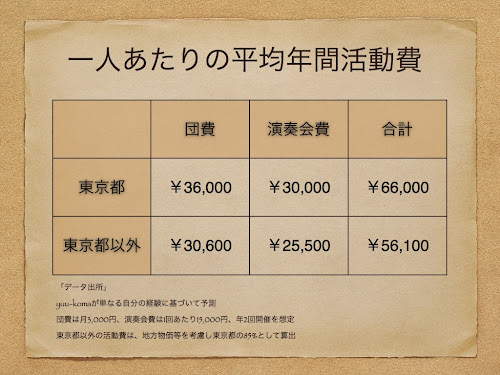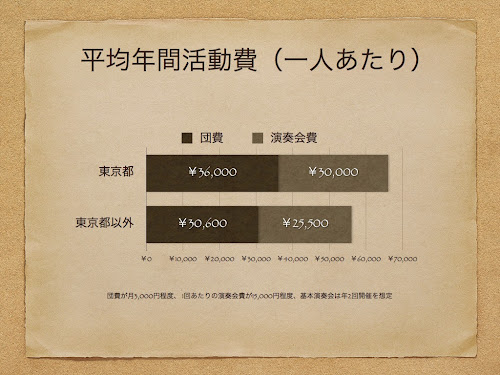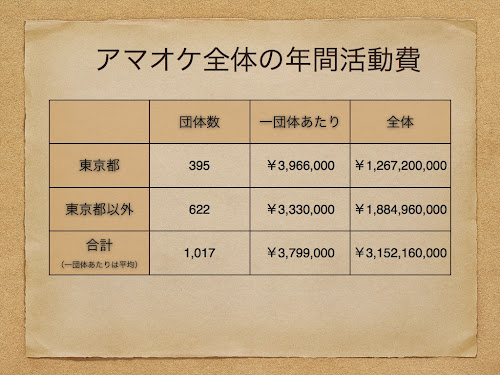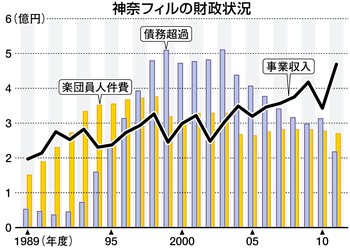I suddenly became curious about it, so I made my own assumptions and did some calculations.
Here’s what I’ve concluded.
「Total annual activity expenses of amateur orchestras in Japan」
全国合計:3,152,160,000円
About 3.2 billion yen. What do you think?
I thought it was surprisingly small scale.
- How did you calculate it?
- Number of amateur orchestra groups and number of effective groups
- Average number of members per group
- Average annual activity cost per person
- Annual activity fee per organization
- Total annual activity expenses of amateur orchestras in Japan
- How did you come up with this estimate?
How did you calculate it?
Now how did you do the math, that’s the key.
In the first place, there are no proper statistics… (There might be if you do more research.)
So, since there is almost no reference data, I forced myself to make assumptions based on experience and guesswork.
I hope you understand that it is only a guide feeling.
Number of amateur orchestra groups and number of effective groups
First, the number of amateur orchestra. Is this familiar? This site
アマチュアオーケストラのサイトFreude http://www2s.biglobe.ne.jp/~jim/freude/
I counted from
The number of amateur orchestras (excluding student orchestras) that were registered on this site was
「アマオケ登録数」
Tokyo: 395 organizations
Outside Tokyo: 622 organizations
Nationwide: 1,017 organizations
(※2012年8月2日時点、アマチュアオーケストラのサイトFreudeよりyuu-komaが自分でカウント)
It was. That’s quite a lot!
Of course, not all of the Amaoke are registered on this site, but considering the performance of this site, I think it is enough coverage.
However, there may be some groups that are not really active. I’m afraid there are some groups that
「勝手な前提1:団体稼働率」
Tokyo: 80
東京都以外:90%
It is very hard to check all the sites of 1,000 organizations….
The reason why the utilization rate of the group outside of Tokyo is 90% is higher than that of Tokyo’s 80% is, again, a selfish guess, but the number of orchestras in the local area itself is probably smaller than that of Tokyo, and there may be backup from the local government. That’s what I thought.
This group utilization rate multiplied by the number of amateur orchestra groups is called
「勝手な前提2:有効団体数=アマオケ数×団体稼働率」
Tokyo: 320 organizations
Outside Tokyo: 560 organizations
Nationwide: 880 organizations
I rounded off the first place because it is too small. In other words, the number of orchestras that are actually active.
Average number of members per group
This one also gives the premise in eya.
「勝手な前提3:Average number of members per group」
全国一律で60人
Average annual activity cost per person
Here is probably the most core assumption. I’ll give this again from experience, eh?
「勝手な前提4:Average annual activity cost per person」
Tokyo Metropolitan area
Average annual membership fee (amount paid regularly): 36,000 yen
Average annual concert fee (amount paid for each concert) 30,000 yen
Total 66,000 yen
Outside Tokyo
Average annual membership fee (amount of money paid on a regular basis): 30,600 yen
Average annual concert fee (amount paid for each concert): 25,500 yen
・合計:56,100円
As an image, the concert fee per time is about 15,000 yen, and the group fee is about 3,000 yen per month. The basic concert is held twice a year.
Some orchestras may have one orchestra a year, and some may have three or more. However, we are averaging around two times.
I thought that an average of two times might be too much, but I set the utilization rate (number of effective groups) roughly conservatively, so I don’t think there is a big deviation.
Also, in the case of a local orchestra, there may be subsidies from the local government, so it may cost a little less money. However, it can be said that this is not necessary to consider (deduct) for the purpose of calculating the pure market size. However, in the case of the provinces, the cost of the venue, etc. is expected to be lower than in Tokyo, so I decided to calculate it at 85% of the cost in Tokyo.
Annual activity fee per organization
Based on the above premise.
「Average number of members per group」×「Average annual activity cost per person」
can be obtained by
You can see the result.
「Annual activity fee per organization」
Tokyo Metropolitan Government: 3,966,000 yen per organization
東京都以外:3,330,000円/団体
Total annual activity expenses of amateur orchestras in Japan
Once you get this far, the rest is easy!
「有効団体数」×「1団体あたりの年間活動費」
can be obtained by
「アマオケ全体の年間活動費総額」
Tokyo Metropolitan Government: 320 organizations x 3,960,000 yen per organization = 1,267,200,000 yen
Outside Tokyo: 560 organizations x 2,550,000 yen per organization = 1,884,960,000 yen
全国合計:3,152,160,000円
How did you come up with this estimate?
I guess what triggered it was hearing this news a while ago!
東京新聞:債務超過解消へ経営改革 神奈フィル 「公益法人移行」で存続危機:神奈川(TOKYO Web) http://www.tokyo-np.co.jp/article/kanagawa/20120725/CK2012072502000114.html
Well, it’s been tough in the music industry these days. In such a situation, classical music, which is naturally in the “minor” category, should not be an exception.
I think that amateur orchestra is one of the driving forces supporting such a severe classical music industry. In fact, they must be making a certain economic contribution to the industry through their activities.
So I thought it would be important to be able to properly discuss economic matters.
So, I wanted to grasp a little bit how big the economy and the market size of the activity of that amateur orchestra is.
The above is the reason why I wrote this blog.
Incidentally, according to the Kanagawa Phil article mentioned earlier, recent business income is just under 500 million yen, personnel expenses are just under 300 million yen, and excess liabilities are about 200 million yen.
東京新聞:債務超過解消へ経営改革 神奈フィル 「公益法人移行」で存続危機:神奈川(TOKYO Web)より
結構おおざっぱな前提での算出とはいえ、とりあえず今回の結論である「32億円」というオーダーはそれなりに参考になるのでは、と思いました。

